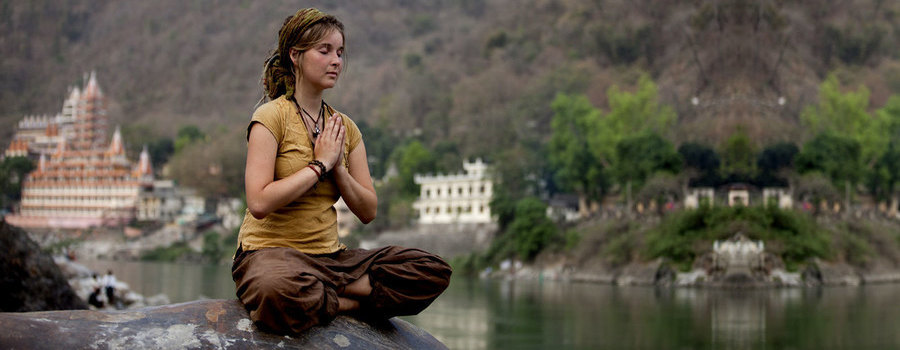

Yoga and Meditation Tour
Places to See: Delhi – Rishikesh – Varanasi - Bodhgaya - Nalanda – Rajgir – Vrindavan - Fatehpur Sikri – Agra

Day 01: Delhi – Rishikesh (220kms/ 6hrs approx)
Arrive Delhi airport meet & greet with our office representative, assistance and direct drive to Rishikesh, check in at hotel. Rest day free for personal activities Yoga, Meditation etc. Overnight at hotel.
Day 02: Rishikesh
Breakfast at hotel, day for personal activities Yoga, Meditation etc.
Yoga is a complete science of life that originated in India many thousand of years ago. It is the oldest system of personal development in the world, encompassing body, mind and spirit. The world yoga means “unity or oneness” and is derived from the Sanskrit world "Yuj" which mean to join, attach and yoke, to direct and concentrate one's attention on to use and apply. On a more practical level, yoga is a means of balancing and harmonizing the body, mind and emotions. This is done through the practice of asana, pranayama and meditation. Yoga is a method of training the mind and developing its powers of subtle perceptions so that man many discover for himself the spiritual truths on which religion, beliefs and moral values finally rest.
The most important thing, however, is that Yoga - with its entire applications and implications - is a powerful means to an end. The ultimate end of all human pursuits is "Moksha." Moksha is freedom from all bondage; freedom from insecurities; freedom from the clutches of desires; freedom from the sense of limitations and inadequacy; freedom from all that thwarts us on our divine journey in life. In other words, the end of all human pursuits is everlasting peace, happiness and a sense of fulfillment. This is possible with steady and prolonged sincere practice of Yoga. It activates a process of cleansing and purification of mind, which in turn, prepares us for the dawning of Self-knowledge. Yoga means this connection; this knowledge that removes the impurities and the veil of ignorance that keeps us strangers to ourselves.
Evening excursion to Ghats visit and Aarti at Har-Ki-Pauri: the sacred Ghat was constructed by King Vikramaditya in memory of his brother Bhartrihari. It is believed that Bhartihari eventually came to Haridwar to meditate by the banks of the holy Ganga. When he died, his brother constructed the Ghat in his name which later came to be known as Har-Ki-Pauri. This sacred bathing ghat is also known as Brahmakund. The reflection of golden hues of floral diyas in the river Ganga is the most enchanting sight in the twilight during the Ganga Arti Ceremony. It is the most important ghat on the river Ganga, where a holy dip is a must for every devotee. Overnight at hotel.
Day 03: Rishikesh
Breakfast at hotel, day for personal activities Yoga, Meditation etc. Overnight at hotel.
Day 04: Rishikesh – Delhi - Varanasi
Breakfast at hotel, drive to Delhi transfer to airport to board domestic flight for Varanasi. At Varanasi airport, meet & greet with our office representative, assistance and transfer to hotel. Rest time free for personal activities.
Evening Ghats’s temples visit & attend Holy Ganga Aarti; Every evening, a magical aarti is performed at Dasashwamedh Ghat. Halt your boat right at the steps for the best view. The presiding priests stand on a wooden chauki in the water. To the chant of Sanskrit mantras, and the clash of cymbals and drums, the river is worshipped with flowers, incense, sandalwood, milk and vermilion. First the blazing camphor lamp and then the many- flamed aarti lamps are raised high and then arched back to the water, the dark river reflecting the golden flames as Ganga accepts the worship. Overnight at Hotel.
Day 05: Varanasi
Breakfast at hotel, excursion to Sarnath: one of the three holiest sites for Buddhists. This is where the Buddha delivered his first sermon in 528 BC. There are many temples here, representing the many cultures where Buddhism is the dominant religious philosophy. You'll find the Tibetans, the Chinese, the Japanese, the Burmese and the Thai have set up centres of learning, monasteries and temples. The Ashokan Pillar here used to be crowned by a capital that had four lions with their backs to each other looking out in the four cardinal directions the capital, now a national emblem for the Indian Union, is in the Archaeological Museum in Sarnath. The Ashokan Pillar, constructed by the legendary King Ashoka (3rd century BC), still stands. There are many stupas here, as is a bodhi tree that is a sapling from the bodhi tree in Sri Lanka. The Bodhi tree is the peepul tree under which the Buddha attained enlightenment. A cutting from the original was planted in Anuradhapura (Sri Lanka), and the bodhi in Sarnath has been grown from a sapling from that.
Afternoon city tour, visit World famous Benaras Hindu University: founded by Pandit Madan Malviya at the turn of the century, also has a new Vishwanath temple. The temple, built by the Birlas, a rich industrialist family, is meant for a caste-less, egalitarian society, Tulsi Manas Temple: Its white marble walls have the verses of Tulsidas’ Ramcharitmanas inscribed on them and Bharat Mata Temple: a modern shrine, inaugurated by Mahatma Gandhi. It has a huge relief map of the Indian sub-continent showing all its rivers, mountains and pilgrimages. Overnight at hotel.
Day 06: Varanasi – Bodhgaya (240kms/ 5hrs approx)
Early morning boat ride and Ghat visit along the Ganges and catch the scene of devotees bathing and praying in the sacred water. Varanasi or Kashi is older than traditions. Varanasi presents a unique combination of physical, metaphysical and supernatural elements. According to the Hindu mythology, Varanasi liberates soul from human body to the ultimate. It is the Ganga Ghats of Varanasi that complement the concept of divinity. Ghats of Ganga are perhaps the holiest spots of Varanasi. The Ganga Ghats at Varanasi are full of pilgrims who flock to the place to take a dip in the holy Ganges, which is believed to absolve one from all sins.
After breakfast check out from hotel, drive to Bodhgaya, check in at hotel.
Afternoon visit, visit Mahabodhi Temple: standing tall at 54mts. A UNESCO World Heritage Site, this temple has been renovated over the years. It enshrines a large golden Buddha, and is encompassed by an ancient railing, dating back to 100 BC. Bodhi Tree: where Buddha is said to have attained enlightenment, and the Vajrasana or throne, where Buddha sat. The tree, acts as a shade to seven holy shrines situated here, said to be the places where Buddha spent a week each meditating, after his enlightenment. Animesh Lochana Chaitya Temple: is where Buddha, in his second week, sat looking at the Bodhi tree, without batting an eyelid. Ratnachankrama is where Buddha spent his third week walking between the Bodhi tree and Animesh Lochana Chaitya, and is also referred to as the Jewel Walk. Ratanaghara Chaitya marks the fourth week of meditation and the Muchhalinda Pond, his sixth week of meditation.
Tibetan Monastery, housing the Maitreya Buddha (future Buddha). Also see the Burmese Temple, Chinese Templeand Monastery, Buddhist Monastery of Bhutan, Thai Temple and Monastery, and many more. Overnight at hotel.
Day 07: Bodhgaya – Nalanda – Rajgir – Bodhgaya (90kms one way)
Breakfast at hotel, full day excursion to Nalanda: A hot seat of knowledge and learning, Nalanda boast of a rich culture and tradition that has gained accolades world wide. Established in the 5th century, the ancient University of Nalanda flourished under the patronage of the various rulers. This tiny village was the favourite place of Lord Buddha and Mahavira who had lived here for several years. There is a fabulous legend behind the name Nalanda, which narrates how this village got its name. It goes like this that the place where the monastery was going to be constructed was the abode of a serpent and while digging the foundation the serpent got injured. The clairvoyants of that time observed that the monastery that would have been constructed in that place would be renowned for a long. Later this Monastery turned to be a great institution of knowledge, whose unparallel credentials gave it a unique seat in the entire history of the nation. A place that carries the rich history, tradition and culture of a great nation Nalanda proffers some unique experience to the visitors. A visit to this tiny hamlet is just like going back to the ancient times. While roaming through the ramparts of stupas, monasteries and viharas one would feel they are walking through the doorsteps of various centuries. It is a must visit place for those who are proud of being a part of such a great culture and interested in knowing the colourful incidents of the past.
Continue drive to Rajgir, visit Vishwa Shanti Stupa: The Vishwa Shanti Stupa is on a 400 m high hill and is built in marble. The four shining statues of Buddha are on the four sides of the stupa. Venu Vana Monastery: King Bimbisar built Venu Vana Monastery as residential quarters for Lord Buddha. It was the very first present to Lord Buddha by the king. Griddhakoota Hill: At Griddhakoota Hill, Lord Buddha set in a motion his second wheel of law or Dharma Pravartan Chakra. Continuously for three months, he gave religious sermons to his followers even during the rainy season. The Buddha Sangha of Japan has constructed a massive modern stupa, the Shanti Stupa or the Peace Pagoda at the top of the hill to commemorate the event. Evening back to Bodhgaya. Overnight at hotel.
Day 08: Bodhgaya – Patna – Delhi - Vrindavan
Breakfast at hotel, drive to Patna airport (110kms/ 3hrs) to board flight for Delhi. From Delhi airport direct drive to Vrindavan (145kms/ 3hrs), check in at hotel.
Later visit, The International Society for Shri Krishna Consciousness (ISKCON) is one of the most beautiful temples in Vrindavan today. The principal deities of this temple are Shri Krishna - Balram and Shri Radha - Shyam Sundar. Adjoining the temple is the samadhi of Shri Prabhupada, the founder of the ISKCON sect, built in pure white marble. The Madan Mohan Temple located near the Kali Ghat which was built by Kapur Ram Das of Multan. This is the oldest existent temple in Vrindavan today. The temple is closely associated with the saint Chaitanya. The original idol of Lord Madan Gopal was shifted from the shrine to Karauli in Rajasthan for safe keeping, during Aurangzeb's rule. Today, a replica of the image is worshipped at the temple. Overnight at hotel.
Day 09: Vrindavan
Breakfast at hotel, visit Devraha Baba (died 1989) was an Indian Siddha Yogi saint who lived beside the Yamuna river in Mathura. He lived on a twelve foot high wooden platform and wore no clothes. A barricade of wooden planks hid his naked body from his devotees. He came down only to bathe in the river. His followers claimed that he was 250 years old when he died in 1989. Devraha was described as a "fully God realized master" and "an ageless saint of legendary repute". One legend has it that Devraha blessed Tulsidas (1532 – 1623), which would make him even over 500 years old. A rough estimate is that around the world, his devotees may number in hundreds of thousands to millions of people.
According to Devraha he wasn't born from a woman's womb, but emerged from water. According to legend, Devraha Baba never ate any food. He is described as a major attraction in the Kumbh Mela. The Baba used to bless his devotees by touching their heads by his foot. The first President of India, Dr. Rajendra Prasad, stated that his father had sat at the feet of Devraha Baba as a child in the middle of the nineteenth century, and Devraha Baba was already elderly at that time. Another notable devotee was Indian prime minister Rajiv Gandhi. Another attributed miracle was his ability to stay underwater for 30 minutes at a time, without resurfacing for air. He could also allegedly understand the language of animals, control wild animals, heal people by his look or word, and tell the future. His samadhi shrine is located across the Yamuna River from the Hindu pilgrimage city of Vrindavan.
Kadamb Grooves of Vindavan; Vrindavan was considered to have the most beautiful forests in India. Urbanization has now destroyed most of it. However 2 small grooves, Seva Kunj and Nidhivan, still exist. It is believed that Lord Krishna played and danced with the gopis at Seva Kunj. At Nidhivan he used to rest with his beloved Radha. Nidhivan also has the Samadhi of Swami Haridas that is daily decorated with flowers by the priest. Govind Deo Temple; Govind Deo temple was built in 1590 by Man Singh, a General of Emperor Akbar, for a huge sum of 1 crore rupees. Emperor Akbar is believed to have donated some red sandstone that was bought for the construction of the Red Fort in Agra towards building this temple.
The temple was built in the form of a 7 storey Greek cross and combined Western, Hindu and Muslim styles of architecture. The original statue of Govindji deity was found 450 years ago by Rupa Goswami but this was later moved to Jaipur when Aurangazeb was in power and tried to destroy the temple. 4 of the 7 storey’s of the temple were destroyed by Aurangazebs men. Today 3 floors of the temple structure still remain. Kesi Ghat; Kesi Ghat is located on the banks of the river Yamuna. Legend has it that Lord Krishna killed the Kesi demon at this ghat. It is believed that if you bath at Kesi Ghat you get the benediction of bathing in all of the holy places. Every evening at sunset an aarti is performed at the ghat. Overnight at hotel.
Day 10: Vrindavan - Fatehpur Sikri – Agra (70kms + 26kms)
After breakfast check out from hotel, drive to Agra Enroute visit Fatehpur Sikri. Built by Emperor Akbar in 1569 and abandoned after 15 yrs. Due to scarcity of water. Predominately, a red sandstone construction sprawling over a huge area, the architectural style is very much in tune with emperor’s dream & partakes of both Hindu & Muslim styles. See the graceful buildings including Jama Masjid, Tomb of Salim Chisti, Panch Mahal & other places.
Salim Chishti Dargah; built by Emperor Akbar in 1569 and abandoned after 15 yrs. Due to scarcity of water. Predominately, a red sandstone construction sprawling over a huge area, the architectural style is very much in tune with emperor’s dream & partakes of both Hindu & Muslim styles. Salim Chishti (1478-1572) was one of the famous Sufi saints of the Chishti Order in India. Salim Chishti was the descendant of the famous Khawaja Moinuddin Chishti whose tomb is in Ajmer, Rajasthan.
Agra, visit Taj Mahal: One of the Seven Wonder of the World was build by Shah Jahan in 1631 AD and was completed in 1651. This symbol of love was build in memory of his wife Mumtaz Mahal. Described as the most extravagant monument ever build for love. It was constructed by Mughal Emperor Shah Jahan as a memorial to his queen Mumtaz Mahal, made out of white marble took 22 years to complete. Ustad Ahamad Lahori, a Parsian Architect, is said to be the main designer and planer of this magnificent memorial. On full moon night, the glory of the Taj is at its best. (Taj Mahal remain closed on every Friday)
Agra Fort: build by the famed Mughal Emperor Akbar in 1565AD, the fort is predominantly of red sandstone. Construction of the massive red sandstone Agra Fort on the bank of the Yamuna River was begun by Emperor Akbar in 1565, though additions were made up until the rule of his grandson, Shah Jahan region it has partially become Palace. The fort presents a good sampling of their favoured architectural styles. Akbar drew on Islamic and Hindu traditions and the result is eclectic. By Shah Jahan's time the style had become so homogenized that it is impossible to separate the Hindu and Muslim strands. The Diwan-I-Am (public audience hall) the beautiful Diwan-I-Khas (private audience hall) were also added by Shah Jahan. Overnight at hotel.
Day 11: Agra – Delhi (204kms/ 4hrs approx)
Breakfast at hotel drive to Delhi city tour of Delhi, drive past Red Fort & Chandni Chowk Bazar.
Visit Jama Masjid (Mosque). Shah Jahan (King of the World) founded the city of Shahjanabad, now referred to as Old Delhi, in 1648. Opposite the fort is the Jama Masjid, one of the largest mosques in the world, built by Shah Jahan to dominate his city. Raj Gath: The memorial of Mahatma Gandhi where he was cremated after his assassination. Qutab Minar: The building complex dated back on the onset of Muslim rule in India and are fine examples of Afghan architecture. Himayun’s Tomb: Build by wife of Humayun, the second mughal king. It is an early example of Mughal architecture. India Gate: The 42m high stone "Arch of Triumph", erected in the memory of Indian soldiers who died in the First World War; Drive through Rajpath "Kingsway" a VVIP area of Delhi including Rashtrapati Bhawan. Laxmi Narayan Temple: Garishly colored modern temple is erected by the industrialist Birla. This temple is dedicated to Laxmi - the goddess of wealth and Narayan - Lord Vishnu, husband of Laxmi. Overnight at hotel.
Day 12: Delhi – Departure
Breakfast at hotel, transfer to airport to board flight for flight for your onward destination.
Searching Availability...












